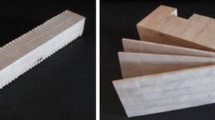Abstract
This paper presents general remarks on the development of timber structures as a result of technological changes. It discusses drawbacks of wood with respect to structural application. Shear and transversal strengths are very low due to the anisotropy of wood. Various techniques are applicable to cope with this drawback. This paper presents the reinforcement by means of tailor made textiles as comprehensive technology to deal with this kind of difficulties in many design situations. Particular importance is attached to the material productivity during the transformation of raw wood into structural cross sections. It is shown that cut offs in the sawmill and the predominating full section lead to a poor use of the material compared to technical profiles. A new understanding of the wood as a cellular solid is presented that allows a thermo-hygro-mechanical forming of cross sections from solid wood panels.
Résumé
Cet article présente des considérations générales sur l’évolution de constructions en bois en␣relation avec les changements technologiques. Il␣discute les inconvénients de l’utilisation structurale du bois. Vu l’anisotropie du matériau, la résistance au cisaillement et celle perpendiculaire aux fibres sont très faibles. Diverses techniques ont été proposées dans le passé pour pallier ces inconvénients. Les renforcements textiles sur mesure sont présentés comme technologie universelle permettant de surmonter ces difficultés dans la construction. Un accent particulier est mis sur la productivité du matériau à l’égard de la transformation de la grume dans une section portante. Il est démontré que les déchets dans la scierie ainsi que les sections solides mènent à une mauvaise exploitation du matériau bois comparée à celle des profilés métalliques et plastiques. Une nouvelle conception du bois comme solide cellulaire est présentée∼; elle permet un formage thermo-hygro-mécanique des sections tubulaires à partir des panneaux de bois massifs.
Similar content being viewed by others
References
Killer J (1998) Die Bauwerke der Baumeister Grubenmann; Lignum/Baufachverlag; 4. Auflage
Zimmer P (2002) Die Konstruktionsgeschichte hölzerner Brücken zwischen 1750 und 1850; Interner Forschungsbericht; Fakultät Architektur der TU Dresden
Herzog Th, Natterer J, Schweitzer R, Volz M, Winter W (2003) Holzbauatlas; Edition DETAIL; Inst. f. internationale Architektur-Dokumentation, München; Vierte Auflage, neu bearbeitet
Herzog Th. (Hrsg.) (2000) Expodach–roof structure at the world exhibition Hanover 2000, Prestel, Munic, London, New York
Sell J (1989) Eigenschaften und Kenngrößen von Holzarten, Baufachverlag AG Zürich
DIN 1052; Entwurf, Berechnung und Bemessung von Holzbauwerken, Sonderdruck, Beuth Verlag GmbH, DIN 1052:2004–08
Kollmann F, Kuenzi E, Stamm A (1975) Principles of wood science and technology, Vol. 1 and 2, Springer Verlag, Berlin
Haller P, Wehsener J Festigkeitsuntersuchungen an Fichtenpressholz (Mechanical properties of densified spruce). In: Holz als Roh- und Werkstoff, Vol. 62, Number 6, December 2004, pp 452–454
Welzbacher CR, Rapp AO, Haller P, Wehsener J (2005) Biological and mechanical properties of densified and thermally modified Norway spruce. In: Proceedings of Second European Conference on Wood Modification, Göttingen, Germany
Lohmann U, Holz Handbuch, DRW-Verlag, 4. Auflage 1990/1993
Gibson L, Ashby M (1997) Cellular solids—structure and properties, 2nd ed. Cambridge Solid State Science Series, Cambridge University Press, Cambridge
Wagenführ R, Scheiber Chr (1989) Holzatlas, 3. Auflage, VEB Fachbuchverlag Leipzig
Gay D (1991) Matériaux composites, 3rd edn. édition Hermès, Paris
Offermann P, Abdkader A, Engler Th, Schierz M (2002) Grundlagen textiler Bewehrungsstrukturen zur Verstärkung bestehender Bauwerke. Research Report of SFB 528,Textile reinforcement in civil engineering, Faculty of Civil Engineering, Dresden University, pp 25–74
Echavarría C, Haller P, Salenikovich A, Analytical study of pin loaded hole in elastic orthotropic plates. Composite Structures, 2005
Haller P, Birk T, Offermann P, Cebulla H, Fully fashioned biaxial weft knitted and stitch bonded textile reinforcements for wood connections. Composites Part B: Engineering, 2006
Mattheck C (1989) Engineering components grow like trees. Research report KfK 4648, Kernforschungszentrum Karlsruhe
Haller P, Putzger R (2005) Fracture energy in mode I and mode II of reinforced wood. In: Abstract book, 11th International Conference on Fracture, Turin, Italy, March 20–25, 2005, p 1224
Aicher S, Gustafsson J (2002) (ed) Haller P, Petersson H, Fracture mechanics models for strength analysis of timber beams with a hole or a notch—a report of RILEM TC-133. Structural Mechanics, LTH, Sweden
Aicher S, Boström L, Gierl M, Kretschmann D, Valentin G, (1997) Determination of fracture energy of wood in mode II. RILEM TC 133 Report, SP Swedish National Testing and Research Institute, SP Report:13
Steinlin H (1994–95) The world’s forests—ecological and economical problems. In: Les constructions en bois, Cycle d’études postgrades, IBOIS, EPF Lausanne
Haller P, Birk T, Putzger R (2002) Physikalische und mechanische Untersuchungen an textilbewehrtem Holz und Holzbauteilen. Research Report of SFB 528, Textile reinforcement in civil engineering, Faculty of Civil Engineering, Dresden University, pp␣283–322
Author information
Authors and Affiliations
Corresponding author
Rights and permissions
About this article
Cite this article
Haller, P. Concepts for textile reinforcements for timber structures. Mater Struct 40, 107–118 (2007). https://doi.org/10.1617/s11527-006-9153-5
Received:
Accepted:
Published:
Issue Date:
DOI: https://doi.org/10.1617/s11527-006-9153-5




